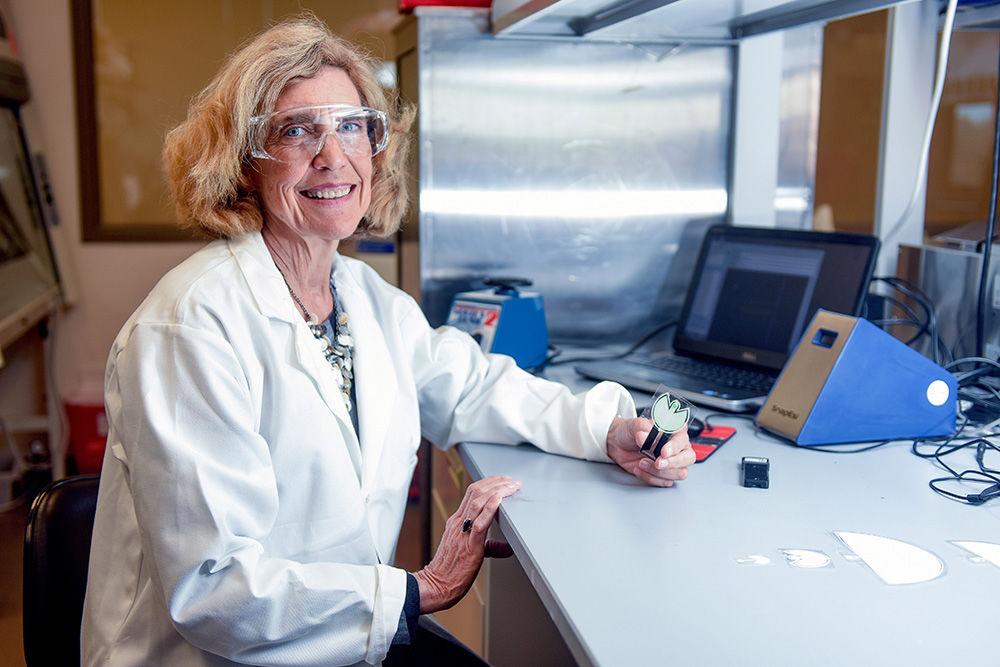 Professor Frances Ligler, Lampe Distinguished Professor in the joint NC State and UNC-Chapel Hill Department of Biomedical Engineering, performs research in the field of biosensors, biomaterials and microfluidics. Ligler said her "work with biosensors and biomaterials is very interdisciplinary." Ligler was inducted into the National Inventors Hall of Fame for her work on optical biosensors." />
Professor Frances Ligler, Lampe Distinguished Professor in the joint NC State and UNC-Chapel Hill Department of Biomedical Engineering, performs research in the field of biosensors, biomaterials and microfluidics. Ligler said her "work with biosensors and biomaterials is very interdisciplinary." Ligler was inducted into the National Inventors Hall of Fame for her work on optical biosensors." />
Courtesy of NC State University Communications
Professor Frances Ligler, Lampe Distinguished Professor in the joint NC State and UNC-Chapel Hill Department of Biomedical Engineering, performs research in the field of biosensors, biomaterials and microfluidics. Ligler said her "work with biosensors and biomaterials is very interdisciplinary." Ligler was inducted into the National Inventors Hall of Fame for her work on optical biosensors.
Only three NC State professors have ever received the honor of being inducted into the National Inventors Hall of Fame, and Frances Ligler, a professor in the Joint Department of Biomedical Engineering (JDBE) at NC State and UNC-Chapel Hill, is among them.
The National Inventors Hall of Fame is a national recognition organization run out of the patent office that has many famous American inventors as members, including Thomas Edison and Eli Whitney. Ligler was recognized for her inventions that further developed optical biosensors.
“[Optical biosensors] is a whole field where biological molecules are being used for recognition and transduce an optical signal to a small device,” Ligler said. “My teams and I demonstrated the use of optical biosensors for detection of pathogens in food, infectious diseases in people, biological warfare agents, environmental pollutants, explosives and drugs of abuse — things that can kill you.”
She explained that the optical sensors worked with many different kinds of samples, including food and groundwater, as the biological molecules used were extremely sensitive and specific only for a particular target.
“A biological molecule, like an antibody or a strand of DNA, has exquisite sensitivity to recognize things that your body sees as foreign, whether it’s a bacteria, a virus or a chemical,” Ligler said. “So, you can use that binding capacity to generate a signal detectable using a small device, equivalent to your cell phone.”
Ligler started her research with a group in the Naval Research Laboratory, the corporate research laboratory for the United States Navy and the United States Marine Corps, where they were trying to solve problems with the Navy.
“Turns out the Navy has all the same problems as everyone else,” Ligler said. “We got into the patent process because we needed incentives to give to companies to actually manufacture the devices that we invented and put them in the hands of the users, both civilian and military.”
At the Naval Research Lab, Ligler and her team were able to develop ways to do multiple detections simultaneously, as well as over long periods of time. Her group tested and commercialized 11 of its inventions.
Although Ligler has been a biomedical engineering professor at NC State since 2013, her background is in biochemistry and immunology, the study of the immune system. Ligler spent nine years working in immunology at both Southwestern Medical School and the DuPont Company, a chemical and health care company.
“When I left the DuPont, I went the Naval Research Lab because they were starting a group looking at self-assembly of biomolecules,” Ligler said. “I thought that sounded like using biomolecules as tinker toys, so it would be fun to see what you could do. At that point, I also realized that there were a lot more problems to solve than just medical ones, and if I really wanted to create something that would help people, I needed to learn engineering.”
Ligler hired many different types of engineers to be a part of the team. With scientists and engineers working with each other to solve problems, they were able to put together the optical sensors.
After 28 years at the Naval Research Lab, however, Ligler decided that she wanted to focus more on the medical problems of the world and help others learn to create useful products. Thus, she joined the JDBE at NC State and UNC-Chapel Hill.
Ligler’s experience working at the university has been positive over the last four years, especially with the creation of the undergraduate Biomedical Engineering Program.
“My biggest problem is there are so many things I could do,” Ligler said. “It’s a challenge to focus and actually get things done. There are so many good people to work with. I have become very excited about our undergraduate program and the opportunities we can offer now that we have undergraduates sharing both institutions. I’ve been spending a lot of time working with faculty and students developing a new undergraduate experience.”
While Ligler is not currently running her own lab, she still is very involved in collaborative research with faculty on both campuses.
Her induction into the National Inventor’s Hall of Fame is a great honor.
“[The induction] does two things,” Ligler said. “It validates, basically, my life’s work in terms of the value of its contribution to the people of this nation, and it’s great PR for NC State.”